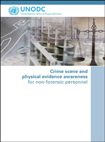|
View in browser: https://www.crime-scene-investigator.net/newsletter/0221.html
|
||
|
FEBRUARY 2021 | ||
| ||
|
This Month's Featured Resource on the Crime Scene Investigator Network Website
|
||

Crime scene and physical evidence awareness for non-forensic personnel United Nations Office on Drugs and Crime The primary target audience of the manual is non-forensic personnel, i.e. first responders and any person involved in the crime scene investigation process without full-fledged training, to help them understand the importance of their actions and the consequences of not applying basic principles of good practice. The manual also targets policy makers, the judiciary and others having to assess, and/or base decisions on evidence presented to them. |
||
|
New CSI and Forensic Job Announcements
|
||
|
The most comprehensive listing of Crime Scene Investigation and Forensic To be notified of job openings as they are posted, follow us on Twitter: Job Posting Alerts |
||
|
Crime Scene Technician
Howard County Police Department, Ellicott City, Maryland, USA Final Filing Date: March 5, 2021 Crime scene investigation: Identify, document, collect, package and preserve physical evidence of various types for laboratory examination and presentation in court as part of police and fire investigations. Photography: Operates digital cameras and other photographic equipment to capture images of crime scenes, victims, and physical evidence. Examines, enhances, and produces images of physical evidence including latent fingerprints, palm prints, and images from photographs and videotape. <View complete job listing> |
||
|
Evidence Technician
Solano County Sheriff's Office, Fairfield, California, USA Final Filing Date: March 5, 2021 The Evidence Technician provides technical assistance by collecting and preserving crime scene evidence and performing photographic laboratory work; examines and processes evidence in the laboratory for trace evidence and latent fingerprints; coordinates the intake, storage, chain of custody and disposal of all evidence. <View complete job listing> |
||
|
Crime Lab and Evidence Supervisor
Santa Maria Police Department, Santa Maria, California, USA Final Filing Date: March 8, 2021 Is responsible for the crime lab and property/evidence bureau. Assists crime lab personnel in the identification, collection, and preservation of evidence at major crime scenes, and in the appropriate photographic and diagrammatic scene representation, laboratory processing, development, collection of latent prints and trace evidence, etc. <View complete job listing> |
||
|
Evidence Technician
Pima County Sheriff's Department, Tucson, Arizona, USA Final Filing Date: March 5, 2021 Takes custody of property and evidence from officers, investigators or technicians under a variety of environmental and physical conditions; Maintains a chain-of custody of all property and evidence received and provides access only to authorized personnel; Testifies in court as to chain-of-custody for property and evidence; <View complete job listing> |
||
 |
||
|
Forensic Scientist II, DNA
North Carolina Department of Justice, Raleigh, North Carolina, USA Final Filing Date: March 3, 2021 Analyzing convicted offender and arrestee DNA samples for upload to CODIS. Expungement of arrestee samples upon request from District Attorney's Offices. CODIS Hit Confirmations. Verification of offense eligibility for database samples. Testifying to the laboratory results in court. Use of the CODIS system. <View complete job listing> |
||
|
IBIS Support Technician
Institute of Forensic Sciences, Houston, Texas, USA Final Filing Date: March 4, 2021 Test fires appropriate calibers and types of firearms. Conducts restoration of obliterated serial numbers on firearms. Receives, releases and maintains evidence submitted for examination. Issue reports accurately reflecting the results of examinations. Testify in court relating to the results of examination. <View complete job listing> |
||
|
Latent Fingerprint Examiner
Miami-Dade County Police Department, Doral, Florida, USA Final Filing Date: March 18, 2021 Develops, evaluates, compares and identifies latent prints; prepares court exhibits and renders testimony in courts of law. Evaluates, enters, compares and identifies prints in the AFIS. Performs latent processes on items of physical evidence utilizing various chemical formulas. Evaluates latent evidence utilizing alternate light sources. <View complete job listing> |
||
|
Deputy Coroner Investigator
Pueblo County Coroner, Pueblo, Colorado, USA Final Filing Date: March 16, 2021 Responds to death scene assignments. Secures the death scene; makes physical examination of deceased; photographs and performs evaluation of the scene. Identifies the deceased. Locates collects and preserves evidence; arranges for technical analysis of evidence as appropriate. <View complete job listing> |
||
|
Search for more job listings in Crime Scene Investigations and Forensics To be notified of job openings as they are posted, follow us on Twitter: Job Posting Alerts |
||
|
Other Resources on the Crime Scene Investigator Network Website
|
||
|
Not Subscribed to this Newsletter?
|
||
|
If you are not subscribed to this newsletter, you may subscribe with this link: SUBSCRIBE via email |
||
|
To Unsubscribe
|
||
|
To unsubscribe from future e-mail alerts, please click here: UNSUBSCRIBE Copyright ©2021 Crime Scene Resources, Inc. Crime Scene Investigator Network |


